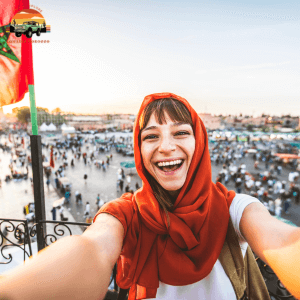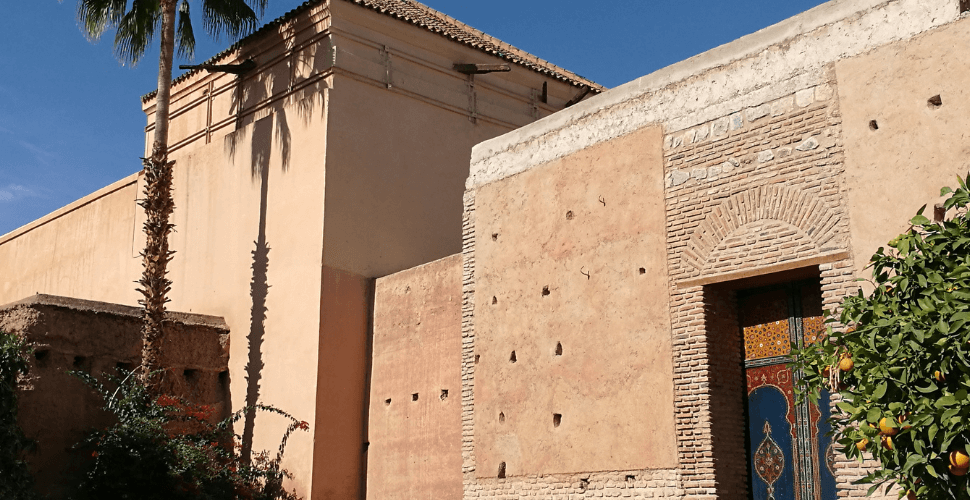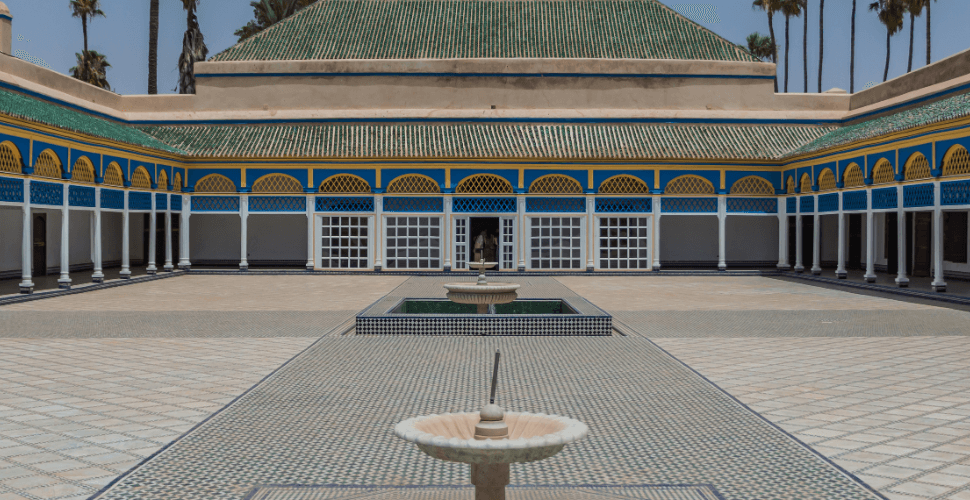The History of Marrakech and Its Importance in Moroccan Culture
Marrakech has a rich history that dates back to the 11th century when it was founded by the Almoravid dynasty. The city served as the capital of Morocco for several centuries and played a crucial role in shaping Moroccan culture and identity. Marrakech was also an important center of trade, attracting merchants from all over Africa, Europe, and Asia.
One of Marrakech’s most iconic landmarks is the Koutoubia Mosque, which was built during the reign of the Almohad dynasty in the 12th century. The mosque’s minaret stands at over 70 meters tall and can be seen from almost anywhere in the city. Another notable historical site is the Bahia Palace, which was built in the late 19th century for a wealthy Moroccan nobleman. Today, visitors can explore its ornate rooms and lush gardens.
Throughout its history, Marrakech has been known for its vibrant arts scene. The city has produced many famous poets, musicians, and artists who have shaped Moroccan culture through their works. One such artist is Majorelle Garden’s founder Jacques Majorelle whose vivid blue garden oasis became one of Morocco’s most visited attractions after being restored by Yves Saint Laurent who bought it in 1980s.

Top Attractions in Marrakech: From the Majorelle Garden to the Bahia Palace

The Majorelle Garden is a must-visit attraction in Marrakech. This botanical garden was created by French painter Jacques Majorelle and features an impressive collection of cacti, exotic plants, and vibrant blue buildings. Visitors can stroll through the tranquil gardens and admire the stunning architecture, including the Art Deco villa that now houses the Berber Museum.
Another popular attraction in Marrakech is the Bahia Palace. Built in the late 19th century for a wealthy Moroccan nobleman, this palace boasts intricate tile work, beautiful courtyards, and ornate ceilings. Visitors can explore various rooms decorated with traditional Moroccan furnishings or relax in one of several lush gardens on site.
For those interested in history and culture, a visit to Koutoubia Mosque should not be missed. This iconic mosque dates back to the 12th century and has become a symbol of Marrakech’s rich architectural heritage. Non-Muslim visitors are not allowed inside but can appreciate its grandeur from outside while taking pictures or enjoying nearby cafes and restaurants with panoramic views of this historic landmark.
The Best Time to Visit Marrakech: Weather and Crowd Considerations
Marrakech is a city that can be visited year-round, but the best time to visit depends on your preferences. The peak tourist season in Marrakech is from October to April when the weather is mild and dry. During this time, the city experiences high occupancy rates and prices are at their highest. If you want to avoid crowds and save some money, consider visiting during the low season from May to September.
Summer in Marrakech can be extremely hot with temperatures reaching up to 40°C (104°F). However, if you don’t mind the heat, this could be an ideal time for budget travelers as hotels offer lower rates during this period. Additionally, Ramadan takes place during May or June each year which means many restaurants may close during daylight hours. It’s important to keep cultural sensitivities in mind when traveling during Ramadan.
If you’re looking for cooler temperatures and fewer crowds while still enjoying good weather conditions then spring (March-April) or autumn (September-November) might be perfect for you. These seasons have pleasant daytime temperatures ranging between 20-30°C (68-86°F), making it easier to explore Marrakech’s outdoor attractions such as gardens and historical sites without feeling too hot or cold.

Where to Stay in Marrakech: Accommodations for Every Budget

When it comes to finding accommodation in Marrakech, there are a variety of options available for every budget. For those looking for luxury, the city offers numerous high-end hotels and resorts such as La Mamounia and Four Seasons Resort Marrakech. These properties offer top-notch amenities including spas, pools, and fine dining restaurants.
For mid-range budgets, there are plenty of riads (traditional Moroccan houses with interior courtyards) scattered throughout the medina. Many of these riads have been converted into boutique hotels that offer a unique experience with traditional Moroccan decor and architecture.
For budget-conscious travelers, hostels and guesthouses can be found throughout the city offering affordable accommodations without sacrificing comfort or location. Options like Hostel Waka Waka or Equity Point Marrakech provide dorm-style rooms as well as private rooms at an affordable price point.
It’s important to note that regardless of your budget, many accommodations in Marrakech require navigating narrow alleyways within the medina on foot or by donkey cart – so be prepared for some walking!
The Food Scene in Marrakech: A Culinary Adventure
Marrakech is a food lover’s paradise, with a vibrant culinary scene that reflects the city’s rich history and diverse cultural influences. One of the most popular dishes in Marrakech is tagine, a slow-cooked stew made with meat or fish and vegetables, flavored with spices such as saffron, cumin, and cinnamon. You can find tagine at almost every restaurant in Marrakech, but some of the best places to try it are at local street stalls or traditional eateries like Chez Lamine.
If you’re looking for something sweet after your meal, be sure to try Moroccan pastries like baklava or chebakia. These delicate treats are made with honey, almonds, and other ingredients that give them their unique flavor and texture. You can find them at bakeries all over Marrakech or sample them at one of the many tea houses in the city.
For a truly authentic dining experience in Marrakech, head to one of the city’s bustling night markets (called souks) where vendors sell everything from fresh produce to grilled meats and seafood. The Djemaa el-Fna square is particularly famous for its food stalls where you can sample local delicacies while enjoying live music and entertainment.

Exploring Marrakech’s Souks: A Shopper’s Paradise

The souks of Marrakech are a must-visit for any shopaholic. These bustling markets offer everything from traditional Moroccan clothing and jewelry to spices, ceramics, and leather goods. The best way to explore the souks is to get lost in the maze of narrow streets and alleys, taking in the sights, sounds, and smells of this vibrant shopping district.
One of the most popular areas within the souks is the Babouchka Market. Here you can find an array of colorful babouches (traditional Moroccan slippers) made from soft leather or intricately embroidered fabrics. You’ll also find stalls selling hand-woven carpets, textiles, and cushions – perfect for adding a touch of Morocco to your home decor.
If you’re looking for something truly unique, head over to Souk Cherratine where you’ll find shops specializing in handmade leather goods. From bags and belts to jackets and shoes – all crafted by skilled artisans using traditional techniques passed down through generations – there’s something here for everyone. Don’t be afraid to haggle with vendors as it’s part of the local culture!
Day Trips from Marrakech: Excursions to the Atlas Mountains and Beyond
The Atlas Mountains are a popular destination for day trips from Marrakech. Visitors can take guided tours to explore the stunning landscapes and traditional Berber villages in the region. One of the most popular excursions is to the Ourika Valley, which offers breathtaking views of waterfalls and terraced fields. Travelers can also visit local souks and enjoy a traditional lunch at one of the many restaurants in the area.
For those looking for more adventure, a trip to Toubkal National Park may be just what they need. The park features Morocco’s highest peak, Mount Toubkal, which stands at over 13,000 feet tall. Hiking trails lead visitors through scenic valleys and up steep mountain paths offering incredible panoramic views of the surrounding landscape.
Another option is a visit to Ait Benhaddou, an ancient fortified city located on the edge of the Sahara Desert. This UNESCO World Heritage Site has been used as a filming location for numerous movies including Gladiator and Game of Thrones. Visitors can wander through narrow alleys lined with mud-brick buildings or climb up to its hilltop fortress for sweeping views of the desert below.

Experiencing Marrakech’s Nightlife: Clubs, Bars, and Traditional Entertainment

Marrakech offers a diverse nightlife scene that caters to all tastes. For those seeking traditional entertainment, head to the famous Jemaa el-Fnaa square where you can watch snake charmers, acrobats, and street performers while sipping on mint tea. The square also has numerous food stalls offering local delicacies such as tagine and couscous.
If you’re in the mood for something more modern, Marrakech has several clubs and bars that are popular with locals and tourists alike. Pacha Marrakech is one of the city’s most famous nightclubs and features international DJs spinning electronic dance music until dawn. For a more relaxed atmosphere, check out Le Comptoir Darna which serves delicious cocktails alongside live music performances.
For a truly unique experience, consider visiting one of Marrakech’s rooftop bars which offer stunning views of the city skyline at night. Sky Bar at La Mamounia Hotel is known for its chic decor and signature cocktails while Nomad Rooftop Terrace boasts a laid-back vibe perfect for enjoying a sunset drink after exploring the souks during the day.
Cultural Etiquette in Marrakech: Tips for Respectful Travel
When visiting Marrakech, it is important to be aware of the cultural etiquette in order to show respect for the local customs and traditions. One key aspect is dress code – both men and women should cover their shoulders and knees when entering mosques or other religious sites. It is also respectful to remove shoes before entering someone’s home.
Another important consideration is communication style. While many locals speak French or English, it can be helpful to learn some basic Arabic phrases such as “salam alaikum” (peace be upon you) as a sign of respect. When bargaining in markets or souks, remember that haggling is expected but it should always be done with politeness and a smile.
Finally, it’s worth noting that alcohol consumption may not be well-received in certain areas of Marrakech due to religious beliefs. If you do choose to drink, stick to licensed bars or restaurants rather than drinking on the street. By being mindful of these cultural norms, travelers can ensure a more enjoyable experience while showing respect for Moroccan culture.

Planning Your Marrakech Adventure: Transportation, Safety, and Other Considerations

Transportation in Marrakech is relatively easy to navigate, with a variety of options available. Taxis are the most common form of transportation and can be hailed on the street or booked through your accommodation. However, it’s important to negotiate the price before getting into a taxi as they don’t always use meters. Another option is to hire a driver for the day if you plan on visiting multiple destinations outside of the city.
Safety should always be a top consideration when traveling, and Marrakech is no exception. While overall crime rates are low in Morocco, tourists may still fall victim to petty theft or scams. It’s important to keep an eye on your belongings at all times and avoid carrying large amounts of cash or valuables with you. Additionally, it’s recommended to dress modestly and respect local customs.
Other considerations when planning your trip include language barriers and cultural differences. French and Arabic are widely spoken in Morocco but English may not be as prevalent outside of tourist areas. Learning some basic phrases in French or Arabic can go a long way in communicating with locals and showing respect for their culture. It’s also important to research cultural norms before arriving so that you can avoid unintentionally offending anyone during your stay.
Unleash the Adventure: Discover Our Excursions
Please note that every route listed on our website is simply a starting point. At our company, we believe in fully customizing every aspect of your trip to meet your specific timing, budget, and preferences. We offer complete flexibility to extend, adjust, shorten, add or even skip stops and towns within a reasonable frame.
Our team of experts will work with you to recommend the best routes and schedules that cater to your interests and create an efficient yet comfortable itinerary. Trust us to take care of all the details, so you can sit back, relax and enjoy your personalized travel experience.










